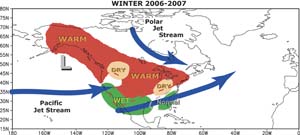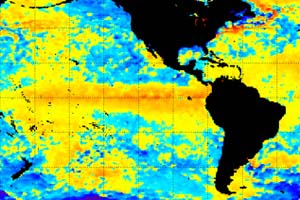| NOAA Magazine || NOAA Home Page |
EL NIÑO GAINS STRENGTH
 Dec.
7, 2006 � The latest El
Niño/Southern Oscillation Diagnostic Discussion, produced
by scientists at the NOAA Climate
Prediction Center, indicates El
Niño conditions are now evident in the tropical Pacific and
should intensify during the next one to three months. However, this
episode is expected to be much weaker than the very strong 1997-1998
El Niño event. (Click NOAA image for larger view of winter
outlook for December 2006 through February 2007, including the position
of the jetstream and what this moderate El Niño event is expected
to produce. Click here
for high resolution version. Please credit “NOAA.”)
Dec.
7, 2006 � The latest El
Niño/Southern Oscillation Diagnostic Discussion, produced
by scientists at the NOAA Climate
Prediction Center, indicates El
Niño conditions are now evident in the tropical Pacific and
should intensify during the next one to three months. However, this
episode is expected to be much weaker than the very strong 1997-1998
El Niño event. (Click NOAA image for larger view of winter
outlook for December 2006 through February 2007, including the position
of the jetstream and what this moderate El Niño event is expected
to produce. Click here
for high resolution version. Please credit “NOAA.”)
“Evolving current conditions in the equatorial Pacific are likely to cause a substantial increase in sea surface temperature along the west coast of South America in late December 2006 and January 2007,” said Vernon Kousky, Ph.D., NOAA’s lead El Niño forecaster. “At about the same time, rainfall is expected to increase over the warm waters in the central equatorial Pacific, thus setting the stage for typical El Niño effects over the U.S. during January through March 2007,” he added.
 El
Niño events influence the predominate position and strength of
the jet stream over the Pacific Ocean, which in turn affect winter precipitation
and temperature patterns across the country. During El Niño events,
the jet stream is stronger than normal across the southern U.S. As a
result, increased storminess and wetter-than-average conditions occur
across the southern tier of the U.S. from central and southern California
across the Southwest to Texas and across the Gulf Coast to Florida and
the Southeast. Meanwhile, drier-than-average conditions are experienced
in the Ohio and Tennessee Valleys, and in the northern Rockies. (Click
NOAA satellite image for larger view of sea surface temperature anomalies
as of Dec. 5, 2006. Click
here for high resolution version. Please credit “NOAA.”)
El
Niño events influence the predominate position and strength of
the jet stream over the Pacific Ocean, which in turn affect winter precipitation
and temperature patterns across the country. During El Niño events,
the jet stream is stronger than normal across the southern U.S. As a
result, increased storminess and wetter-than-average conditions occur
across the southern tier of the U.S. from central and southern California
across the Southwest to Texas and across the Gulf Coast to Florida and
the Southeast. Meanwhile, drier-than-average conditions are experienced
in the Ohio and Tennessee Valleys, and in the northern Rockies. (Click
NOAA satellite image for larger view of sea surface temperature anomalies
as of Dec. 5, 2006. Click
here for high resolution version. Please credit “NOAA.”)
“NOAA’s investment in climate models is paying off,” said Jim Laver, director of the NOAA Climate Prediction Center. Statistical and coupled model forecasts, including the NOAA National Centers for Environmental Prediction Climate Forecast System, show El Niño conditions peaking during the northern hemisphere winter (December 2006 through February 2007) and then weakening during the northern hemisphere spring (March through May 2007). “This event may be with us for a while, and we will be closely monitoring how the atmosphere reacts,” he said.
The term El Niño refers to the large-scale ocean-atmosphere climate phenomenon linked to a periodic warming in sea surface temperatures across the central and east-central equatorial Pacific (between approximately the date line and the South America coast). El Niño represents the warm phase of the El Niño/Southern Oscillation, or ENSO, cycle, and is sometimes referred to as a Pacific warm episode. Originally, the term referred to an annual warming of sea surface temperatures along the west coast of tropical South America. Typically, El Niño episodes occur every 3 to 5 years. However, in the historical record this interval has varied from 2 to 7 years.
The next El Niño/Southern Oscillation Diagnostic Discussion will be published (via the Internet) on January 11, 2007.
In 2007 NOAA, an agency of the U.S. Commerce Department, celebrates 200 years of science and service to the nation. Starting with the establishment of the U.S. Coast and Geodetic Survey in 1807 by Thomas Jefferson much of America's scientific heritage is rooted in NOAA. The agency is dedicated to enhancing economic security and national safety through the prediction and research of weather and climate-related events and information service delivery for transportation, and by providing environmental stewardship of the nation's coastal and marine resources. Through the emerging Global Earth Observation System of Systems (GEOSS), NOAA is working with its federal partners, more than 60 countries and the European Commission to develop a global monitoring network that is as integrated as the planet it observes, predicts and protects.
Relevant Web Sites
El
Niño/southern Oscillation (ENSO) Diagnostic Discussion
Weekly Update: ENSO Cycle: Recent Evolution, Current Status and Predictions (Click PowerPoint or PDF)
NOAA’s El Niño Southern Oscillation
NOAA Satellite Images of Sea Surface Temperature Anomalies
Media
Contact:
Carmeyia Gillis, NOAA
Climate Prediction Center, (301) 763-8000 ext. 7163